Rosetta timeline
 |
Launch On 2 March 2004 Rosetta launches with its lander Philae into space on board an Ariane-5 G+ rocket from Europe’s spaceport in Kourou, French Guiana. This marks the start of a 10-year journey that will lead Rosetta to its destination comet: 67P/Churyumov-Gerasimenko. |
 |
1st Earth gravity assist On 4 March 2005 Rosetta swings by planet Earth at a distance of 1954 km above the Pacific ocean. This flyby is the first in a series of ‘gravitational kicks’ that Rosetta will undergo during its journey. The boost is needed to get the spacecraft onto the correct trajectory to be able to meet up with the comet in August 2014. |
 |
Mars gravity assist On 25 February 2007 Rosetta swings by Mars passing just 250 km from its surface, and takes an unforgettable self-portrait with the Red Planet in the background. At Mars Rosetta gets its second gravitational boost to help change the spacecraft’s direction. |
 |
2nd Earth gravity assist On 13 November 2007 Rosetta swings by the Earth once more and whizzes past 5295 km overhead taking beautiful pictures of our planet and the Moon. With this swing by the spacecraft is catapulted towards the outer Solar System with newly-gained energy before coming back to Earth for another boost. |
 |
Encounter with asteroid Steins On 5 September 2008 Rosetta flies by asteroid 2867 Steins at a distance of 800 km during the spacecraft’s excursion through the main asteroid belt, located between the orbits of Mars and Jupiter. Steins, an asteroid measuring 5 km across and whose diamond shape is revealed by Rosetta for the first time, is the first scientific target of Rosetta on its way to the comet. |
 |
3rd Earth gravity assist On 13 November 2009 Rosetta skims past our planet at a distance of 2481 km to pick up its last gravitational boost. At this point, after having flown a little over 4500 million km of its 7100 million km journey, Rosetta has now gained enough energy to achieve its rendezvous with comet 67P/Churyumov-Gerasimenko. |
 |
Encounter with asteroid Lutetia On 10 July 2010 Rosetta flies by asteroid Lutetia, its second scientific target, at a distance of 3162 km. Rosetta reveals a battered world of many craters, most probably a primitive survivor from the violent birth of the Solar System. Lutetia’s longest side is around 130 km. |
 |
Rosetta enters hibernation On 8 June 2011 Rosetta enters a long, dark hibernation that will last for two and a half years and during which virtually all systems on the spacecraft are shut down. In this way Rosetta can survive its enormous distance from the Sun and the weakness of the sunlight falling on its solar panels, which cannot produce enough electricity to power the probe fully. |
 |
Rosetta wakes up On 19 January 2014 Rosetta’s internal alarm clock wakes up the spacecraft. On one of the most exciting moments for Rosetta scientists and mission operators on Earth, the spacecraft calls back home confirming everything is working fine and that it has survived the most distant part of its journey. |
 |
Rosetta gets first sight of the comet On 20 March 2014, at about 5 million kilometres distance, Rosetta catches a first glimpse of comet 67P/Churyumov-Gerasimenko, now visible as just a little dot in the sky. |
 |
Approaching the comet Between May and August 2014 Rosetta performs a series of complex manoeuvres to reduce the separation between the spacecraft and comet from around 20 million km to 100 km. From this close distance, scientists can determine the best landing spot for the Philae lander. |
 |
Rosetta arrives at comet On 6 August 2014 Rosetta arrives at the comet and takes a series of breath-taking images. 67P/Churyumov-Gerasimenko is a small comet just 4 km in its longest dimension, with an incredible duck-like appearance and a diverse surface: a true treasure trove for Rosetta scientists, eager to start their exploration adventure. |
 |
Philae landing site is selected On 15 September 2014 ESA announces the best spot for Philae to land, called ‘J’. |
 |
Philae lands on the comet! On 12 November 2014 the Philae lander was released by the Rosetta spacecraft and touched down on the comet: a first in the history of space exploration. Landing on a comet, a tiny low-gravity celestial body moving at a speed of several tens of thousand km/h, was never achieved before. |
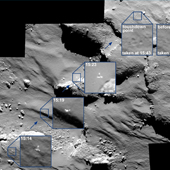 |
Philae science at comet Along with some other instruments on Philae, the Ptolemy instrument to operate at more than one location on the comet’s surface. Ptolemy performed its first 'sniffing' measurements on the comet just after the initial touchdown of Philae and returned data from its various stops on the comet. However, the data are complex and will require careful analysis: this will take time. |
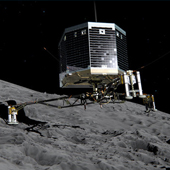 |
Philae wakes up from hibernation Rosetta's lander Philae has woken up after seven months in hibernation on the surface of Comet 67P/Churyumov-Gerasimenko. The signals were received at ESA's European Space Operations Centre in Darmstadt at 22:28 CEST on 13 June 2015. More than 300 data packets have been analysed by the teams at the Lander Control Center at the German Aerospace Center (DLR). |
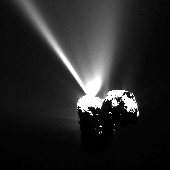 |
Closest approach to Sun ESA’s Rosetta witnessed Comet 67P/Churyumov–Gerasimenko making its closest approach to the Sun on 13 August 2015. The exact moment of perihelion occurred at 02:03 GMT in the morning when the comet came within 186 million km of the Sun. Monitoring the comet’s changing environment in the lead up to, during and after perihelion is one of the primary long-term science goals of the mission. |
 |
Comet surface changes before Rosetta’s eyes Since arriving at Comet 67P/C-G in August 2014, Rosetta has been witnessing an increase in the activity of the comet, warmed by the ever-closer Sun. An increase in the outflow of gas and dust has been punctuated by the emergence of jets and dramatic outbursts in the weeks around perihelion. But in June 2015, just two months before perihelion, Rosetta scientists started noticing important changes on the surface of the nucleus itself. |
 |
Rosetta reveals comet’s water cycle Scientists using Rosetta’s Visible, InfraRed and Thermal Imaging Spectrometer, VIRTIS, have identified a region on the comet’s surface where water ice appears and disappears in sync with its rotation period. The data, concentrating on a one square km region of the neck, suggest that water ice on and a few centimetres below the surface ‘sublimates’ when illuminated by sunlight, turning it into gas that then flows away from the comet. |
 |
How Rosetta's comet got its shape The origin of Comet 67P/Churyumov–Gerasimenko’s distinctive ‘rubber duck’ shape (or double-lobed form) has been a key question since Rosetta first revealed its surprising shape in July 2014. By using high-resolution images taken between 6 August 2014 and 17 March 2015 to study the layers of material seen all over the nucleus, they have shown that the shape arose from a low-speed collision between two fully fledged, separately formed comets. |
 |
First detection of molecular oxygen at a comet ESA’s Rosetta spacecraft has made the first in situ detection of oxygen molecules outgassing from a comet, a surprising observation that suggests they were incorporated into the comet during its formation. Oxygen is the third most abundant element in the Universe, but the simplest molecular version of the gas, O2, has proven surprisingly hard to track down, even in star-forming clouds, because it is highly reactive and readily breaks apart to bind with other atoms and molecules. |
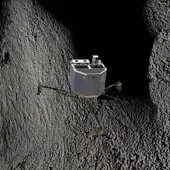 |
Rosetta's lander faces eternal hibernation Silent since its last call to mothership Rosetta on 9 July 2015, the Philae lander is facing conditions on Comet 67P/Churyumov–Gerasimenko from which it is unlikely to recover. Rosetta continues its scientific investigations at the comet until September 2016 before its own comet-landing finale. |
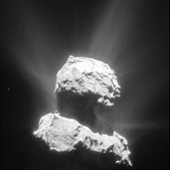 |
Rosetta's comet contains ingredients for life Ingredients regarded as crucial for the origin of life on Earth have been discovered at the comet that ESA’s Rosetta spacecraft has been probing for almost two years. They include the amino acid glycine, which is commonly found in proteins, and phosphorus, a key component of DNA and cell membranes. |
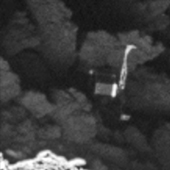 |
Philae found On 2 September Rosetta’s high-resolution camera has revealed the Philae lander wedged into a dark crack on Comet 67P/Churyumov–Gerasimenko. The OSIRIS narrow-angle camera as the orbiter came within 2.7 km of the surface and clearly show the main body of the lander, along with two of its three legs. The images also provide proof of Philae’s orientation, making it clear why establishing communications was so difficult following its landing on 12 November 2014. |
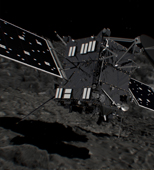 |
End of mission On 30 September the Rosetta mission will come to an end with a controlled descent to the surface of Comet 67P/Churyumov–Gerasimenko for a "soft landing" that should provide a last crop of unique data. After two years living with the comet, this mission has already returned an unprecedented wealth of scientific information. Rosetta’s results are playing an important role in scientists' view of the evolution of our Solar System, including our home planet. |

